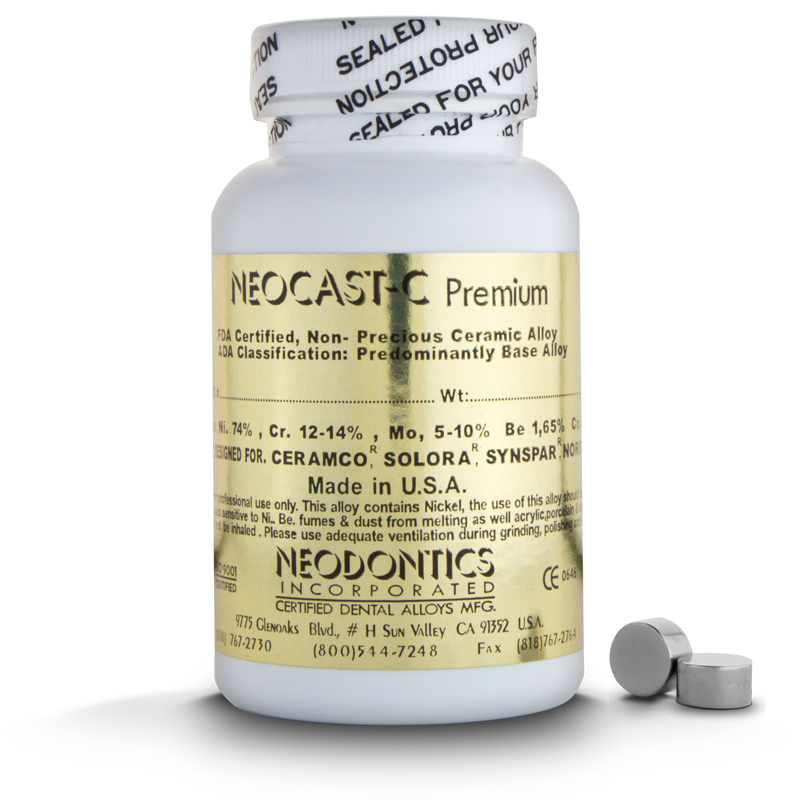Section I
Material Identification
Nickel-Chromium Alloy
Material Name
Neocast C
Section II
Ingredients & Hazards
| Ingredients |
Cas # |
% Composition by weight |
| Nickel (Ni) |
(7440-02-0) |
75% |
| Molybdenum (Mo) |
(7439-98-7) |
5% |
| Chromium (Cr) |
(7440-47-3) |
14% |
| Aluminum (Al) |
(7429-90-5) |
2% |
| Cobalt (Co) |
(7440-48-4) |
<1 |
| Beryllium (Be) |
(7440-41-7) |
1.65% max. |
| Titanium (Ti) |
(7440-32-6) |
<1 |
Hazard Data
- For pure Beryllium (Fumes & Dust)
- 8 hr. TLV-2mg/m³
- Ceiling level-5mg/m³
- Max. for 30 Min.-25mg/m³
- For pure Molybdenum (Fumes & Dust)
- 8 hr. TLV-5mg/m³
- Pure Nickel & Chromium (Fumes & Dust)
- 8 hr. TLV- 1mg/m³
Section III
Physical Data
| Melting Range |
2174º - 2220ºF (1190°-1216°C) |
| Specific gravity |
7.7 gm/cm³ |
| Solubility in water |
None |
| Appearance |
A silver/platinum color |
| Odorless |
|
Section IV
Fire & Explosion Data
These alloys are fire and explosion resistant
Section V
Reactivity Data
At high temperatures, these alloys will oxidize, but are stable. At very high temperatures, these alloys may produce fumes.
Section VI
These alloys contain Nickel, Chromium, Molybdenum, Aluminum, Beryllium (1.8% Max.), and traces of Cobalt. University studies have established that alloys in these categories are not only biocompatible, but clinically safe as well. The alloy in solid form is generally not considered hazardous. Grinding, melting, cutting or any other process that releases dust or fumes can produce hazardous levels and should be avoided.
First Aid
Eye Contact
Flush eyes Thoroughly with running water, even under eyelid.
Skin Contact
Flush skin and scrub thoroughly with soap and water.
Inhalation
Remove person to fresh air. Assist breathing with additional oxygen if necessary.
Section VII
Spill or Leak Procedures
Remove dust by vacuuming or wet sweeping to prevent powdering in the air. Wear respirators and protective clothing. Use disposable containers. No special precautions are required for bulk (solids) shapes, such as ingots and buttons.
Section VIII
General and local ventilation and exhaust filtration should be employed. Respirator, goggles, gloves, and coveralls or protective clothing should be used. Also, periodic physical examinations should be taken.
Section IX
Special Precautions
Avoid inhalation of fumes and dust. Avoid skin contact. Wear protective clothing. This alloy contains Beryllium. Beryllium dust can be toxic. Do not inhale. Grind and polish with adequate ventilation only.
This alloy contains Nickel and should not be used for individuals with known Nickel sensitivity. Dust containing Nickel should not be inhaled. Melting and fabrication of this alloy should be done in the presence of adequate ventilation.
Additional Precautionary Notes:
First Aid Measures
If dusts or smokes are inhaled, sufficient fresh air should be provided. In case of eye contact, eyes should be rinsed thoroughly for several minutes under running water. If ingested or swallowed, a doctor should be consulted immediately.
Fire Fighting Measures
The material is inflammable and not oxidizing. In case of large quantities of dust, the danger of a dust explosion is present. Toxic reaction products may occur by high temperatures. All extinguishing agents are suitable. Favorable are sodium chloride and dry sand.
Handling and Storage
By appropriate application, no special measures needed for handling or storage. Sufficient suction should be guaranteed.
Exposure Controls and Personal Protection
Respiratory protection can be maintained by ensuring suitable suction, and if applicable use respirator or filter. If necessary, use safety goggles for eye protection. Protective gloves can provide hand protection and prevent certain known allergies of alloy components, such as Nickel. During working with alloy and metals, do not eat, drink, smoke or snuff tobacco. Regarding legal instructions for working hygiene, wash face and hands before break and/or of work.
Stability and Reactivity
In case of contact with acids, the formation of hydrogen is possible. Dusts due to processing (e.g. casting, grinding) may cause dust explosion, in extreme cases.
No dangerous reactions are known to occur with correct handling and storage.
Normally chemical substances which accumulate as residual material, are special refuses. The removal is defined by legal waste management laws and corresponding regulations. In case of doubt, contact the public authorities. Prevent from dumping materials into soil, water, and drainage system.

